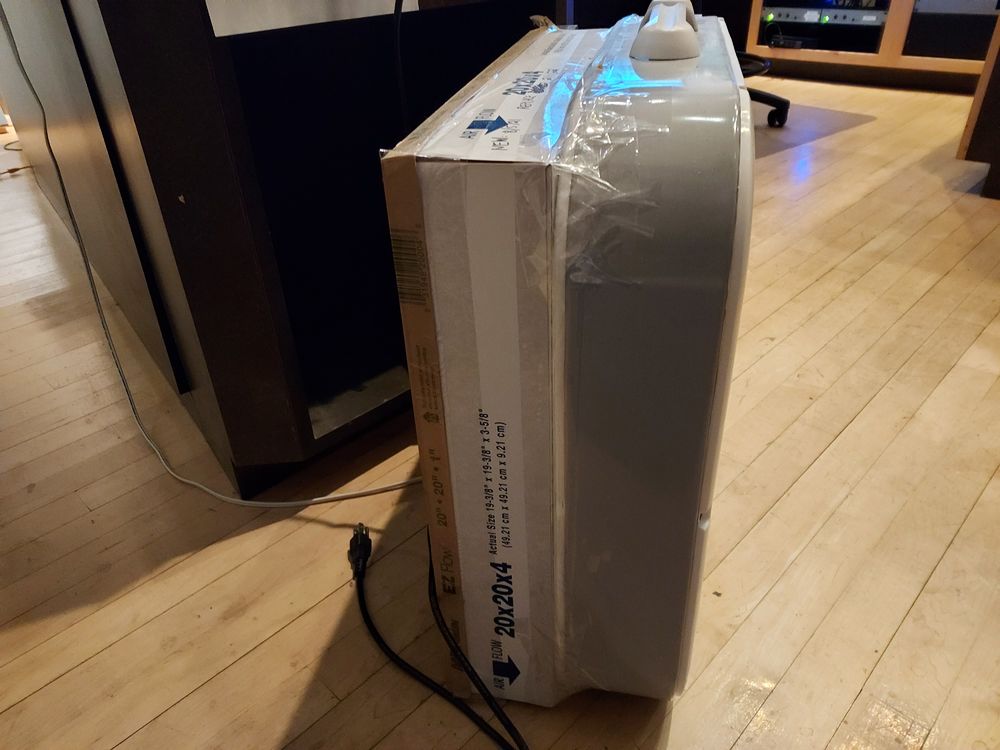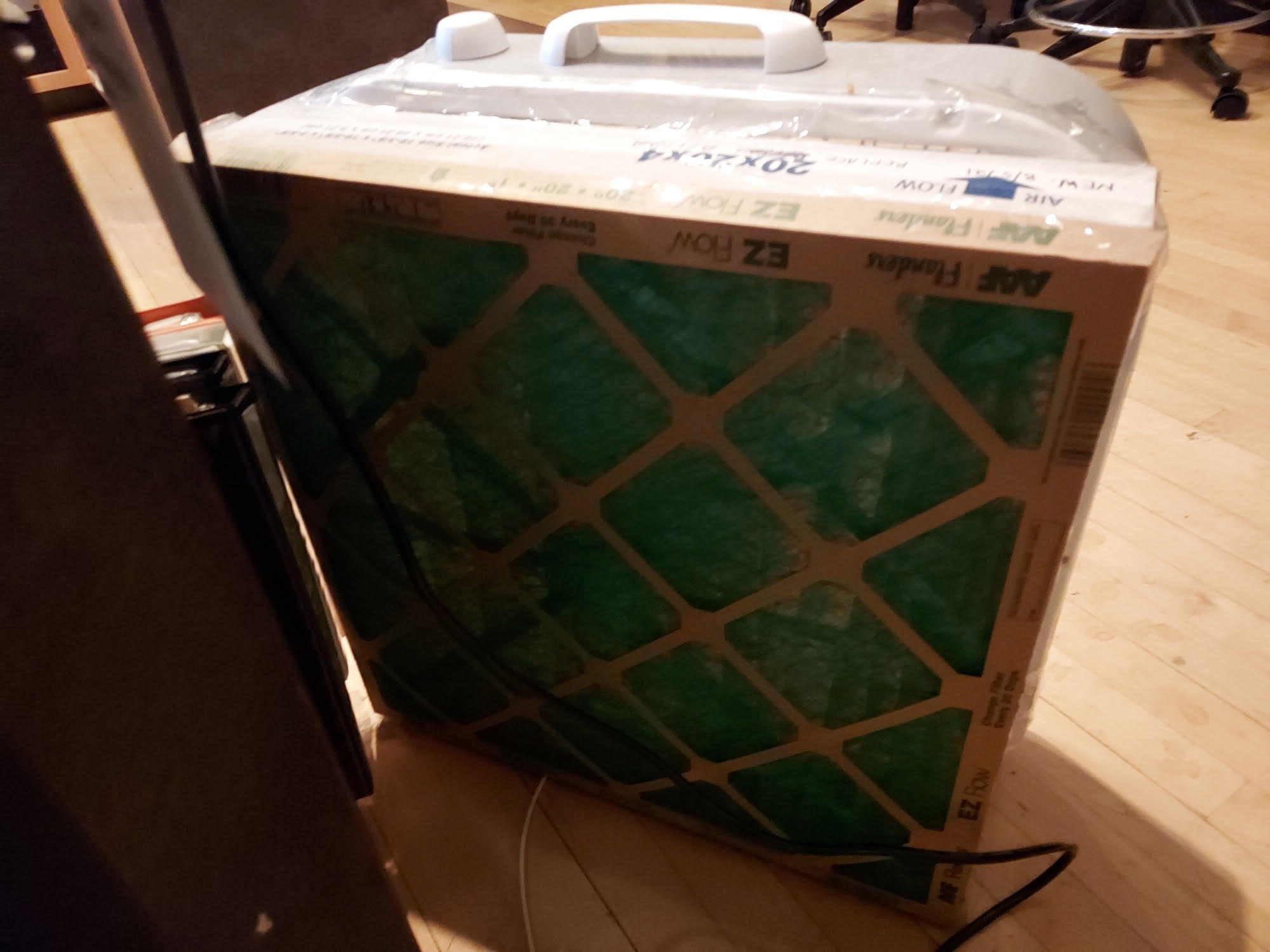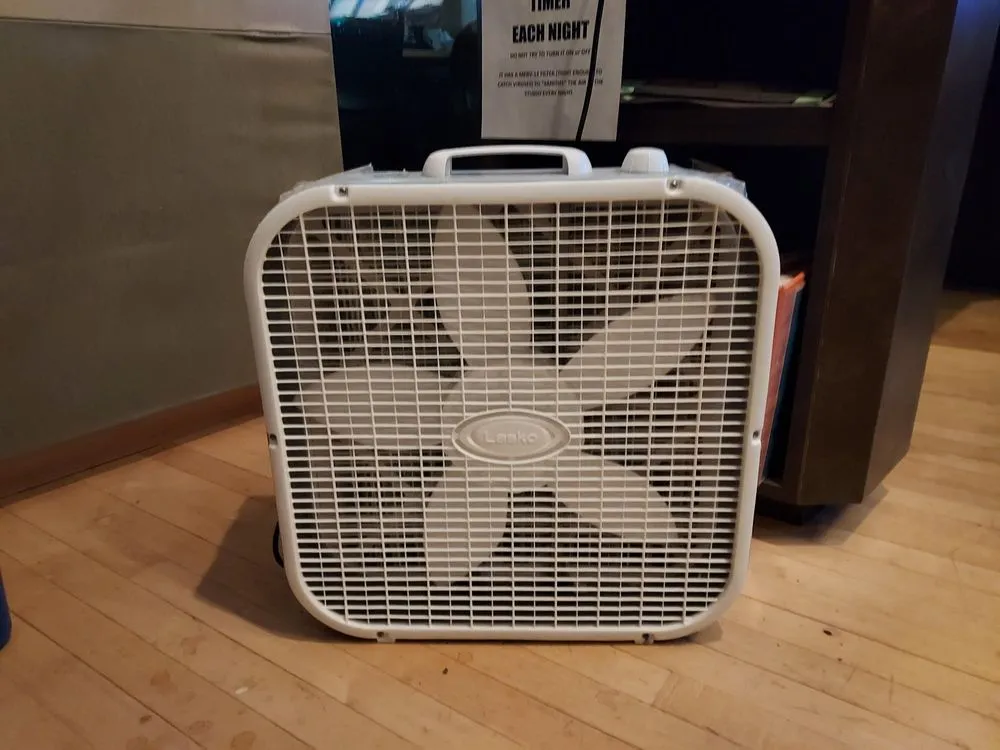Ed note: these box fan air filters are better-known as Corsi-Rosenthal Boxes. But at the time of authoring this piece, I hadn’t heard of that term.
—-
Looking for a cheap and easy way to add some better air filtration to your studios as we live in COVID19’s world? Here’s a simple DIY project you can do that does actually seem to help. Of course, having your employees (and visitors) be fully vaccinated as the CDC defines it, and to wear N95 or KN95 face masks as much as possible, if not all the time, are just as important as air filtration. But this idea can certainly complement your other actions to help stop the spread of COVID.
Right at the beginning I will say that for my day job as The Public’s Radio Chief Engineer, I shamelessly copied this concept from Dan Houg, Chief Engineer at KAXE (retired) in Grand Rapids, Minnesota, early in the pandemic. It’s a brilliant concept he came up with and graciously shared with the PUBtech email listserv for public radio engineers.
Parts List
You will need the following items:
- 20 inch box fan. The basic $20 edition from Lasko at Home Depot will do fine.
- Mailing/packing tape, or duct tape. Either will do, but mailing tape will last longer. You can also get it from Home Depot, or Staples, or anywhere that sells office supplies or home improvement. Buy a LOT of it because you don’t want to be stingy on the tape; you want a lot to make a good seal.
- 20x20x4in MERV13 air filters. It’s important to get both the MERV13-rated filters and the 4in deep/thick filters. I got mine at FilterBuy.com – Home Depot and Lowes did not carry them in this thickness. The MERV13 is fine enough that it traps the particles that can carry the COVID19 virus. The 4-inch depth provides more surface air to allow sufficient air flow. They also last a lot longer before needing replacement.
- 20x20x1 fiberglass dust filters. I used Flanders E-Z Green Nested Fiberglass (MERV1), available in four-packs at Home Depot. The MERV rating here is less important as this is just to keep household dust out of the MERV13 filters.
- Lamp Timer Switches. Anything that your box fan can be plugged into will do; these are fine.
- Extension cords. You may or may not need these depending on where you want to put the fan.
How to Assemble
First, remove any “feet” from the bottom of the box fan. Then, tape over any holes in the frame of the fan.

Check the MERV13 filter for the direction of the air flow (there’s usually a label on the sides). Place it on the back of the box fan, with the arrow pointing into the fan. Run a LOT of tape around the perimeter to seal it to the fan’s case. You’ll need two or three overlapping layers of tape to get a good seal. It doesn’t have to be watertight, but you want it sealed well enough that when the fan is running, it’s sucking air through the filter…not from around the edges.
Then take the fiberglass MERV1 filter and place it over the MERV13 filter (the direction doesn’t matter here). Tape the heck out of the perimeter again to seal the MERV1 to the MERV13. Same principle: you’re trying to force the air through the filter so don’t give it any other means of getting around the filter.
That’s it!
How to Use / Where to Place
As you would expect, a filter as “fine” as MERV13 really restricts the airflow. So the fans need to run at 2, sometimes 3, just get any air moving at all…and you need that air movement. The idea is that you want the fan to blow air in a way that moves all around the room as much as possible. That might be in the middle, it might be more strategically blowing along a certain wall. It’ll depend on the room.
Don’t be afraid to put the fan on a table or chair to get it up higher so it has better airflow, too.
Your average box fan at speed 2 or 3 tends to be kinda noisy, so you’ll have to take that into account when choosing a location in your studio as well.

Timing is Everything
One alternative you can do is what we did at The Public’s Radio; we limit how many people have access to each studio. That allows us to put the fan/filters on timers and run them for 4 or 5 hours every night, when nobody is there.
First we break people down into two categories: airstaff, and everyone else.
Airstaff is the morning host, afternoon host, and weekend host. They are a pretty stable group of people who are in Studio A on a regular basis. Studio B, C and D are only used infrequently.
For “everyone else”, we only let one person per day into Studios B, C and D. That way we can be sure there’s a time the fan will run and “purify” the air after someone has been in there. We can, and do, stretch that a bit when the people involved are fully vaccinated and they switch on the fan as they leave the Studio. Nobody goes in there for at least an hour (things usually work out that way) while the fan runs, then they turn off the fan.
Note: by “switch on” or “turn off” the fan, I mean they flip the switch on the lamp timer that changes between “always on” and “on via timer”. The fans still run every night on the timer as they should.
In addition to “filtering” the air, this also gives crucial time for any aerosols or droplets that might contain COVID viruses to dry out and the virus to die.
Changing the Filters
If your studios aren’t terribly dusty and/or aren’t used very often, you may find you can go weeks or months or even years between changing the filters. Check them every 4 to 8 weeks to see if there’s dust buildup on the fiberglass filter. And this probably goes without saying, but if someone tests positive for COVID who’s been in the studios within the last two weeks? Change out all the filters, just to be safe.
How to change them? Take a box cutter and cut the tape between the filter & fan, then throw away the filter. Don’t worry too much about removing leftover tape on the fan (esp if it’s packing tape vs duct/duck tape) Re-assemble from scratch using new filters. That’s all!

Side Benefits!
One additional side benefit we discovered: one of our employees has mild asthma and told me they noticed after a few days that while things weren’t bad before, suddenly he had no “tickling cough” issues at all anymore. The air seemed noticeably less dusty to them.
I found this interesting yet strange given that we have 20x20x1in air filters on the closed-loop HVAC system in each studio and the filters are changed every 3 to 6 months. Oh well, good results speak louder than theories, eh?
Alternatives
TPR CEO Torey Malatia sent me a link to a story about how Arizona State University students were employing a similar DIY approach to improving air quality and COVID filtering in their classrooms. This story from ABC15 Arizona is frustratingly short on details, but you can infer some things about the design in the below pic.

It would appear they’re making the overall assemblies much larger, but I think they’re using filters with a much lower MERV rating. I’m not sure how effective that is against COVID; you need pretty tight filtering to deal with aerosols that can carry viruses. I think the cardboard circular cutouts on the front of the fans is largely unnecessary, though. Still, I like the more omnidirectional air flow for the intake and the straight-up outflow; that should help with getting air movement all over the room. It’s certainly a concept worth exploring and seeing how it works for your studios!
Again, big thanks to Dan Houg, who just retired from KAXE and now does TheFixitWorkshop, and also to Chuck Leavens who runs the PUBtech listserv.

Leave a comment